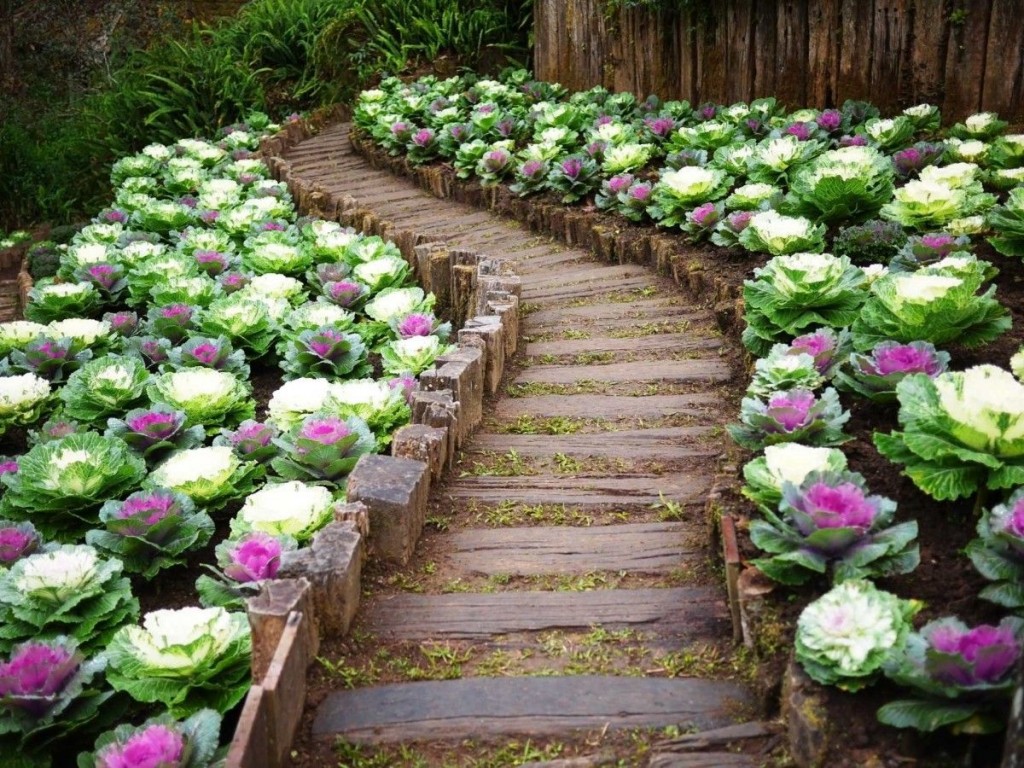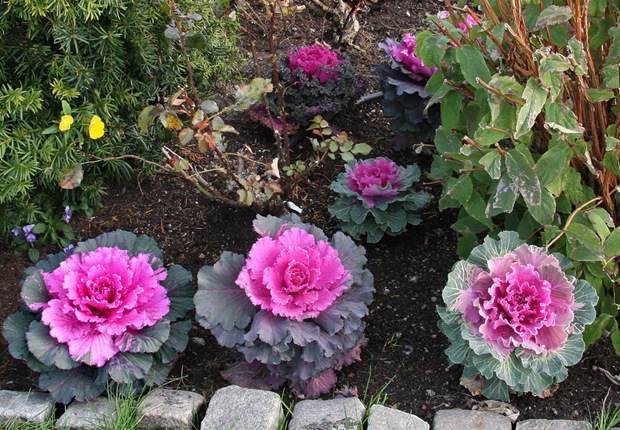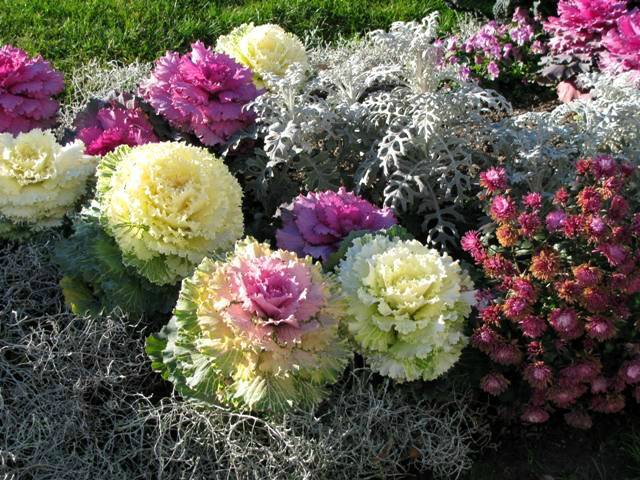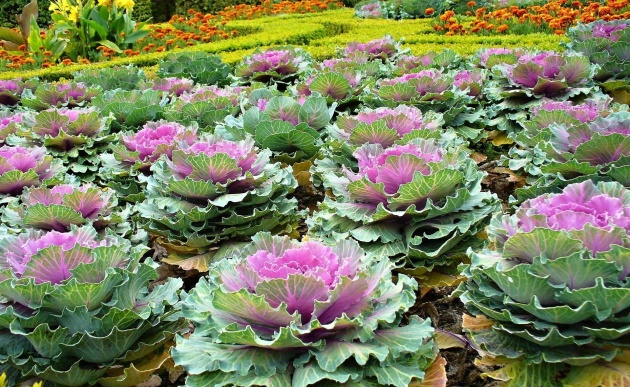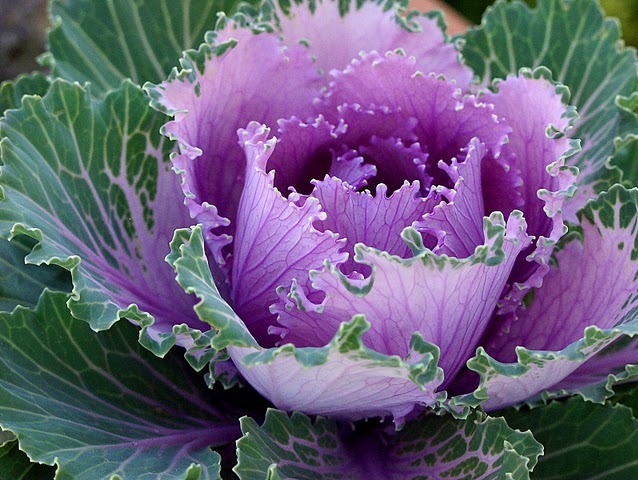How to decorate a plot with ornamental cabbage
Content
Description
Long known to vegetable growers, ornamental cabbage became fashionable thanks to Japanese breeders who, from the end of the twentieth century, began to create new varieties of varied and sophisticated appearance. This oriental beauty turned out to be unpretentious in breeding and very resistant to a drop in air temperature. The more severe the weather, the brighter and more juicy its colors look: frost, she becomes a real queen. She is not afraid of a drop in temperature to -8 degrees.
Ornamental kale looks like a rose, with a bright flower framed by more delicate green petals. If you dig it up at the end of autumn with a large earthen lump and, after transplanting it into a pot, bring it indoors, it will retain its beauty all winter. Or you can just cut it off and put it in water - it will decorate the apartment for at least a month. A favorite of park designers in Europe and Japan, ornamental cabbage belongs to biennial plants. In the first year of vegetation, cabbage leaves (which so resemble flowers) are formed, and in the second - flowers and fruits.
Representatives of different varieties of this amazing plant look very differently. The height varies from 20 to 130 cm, and the diameter of the rosette can reach 1 m.The length of the leaves can range from 20 to 60 cm, and the width is from 10 to 30 cm. Some plants are like palm trees, while others are like a rose flower that sprouted directly from land. The shape of the leaves is striking in variety: they can be round, fringed, with various cuts or openwork, like bizarre algae. Green in different shades can be decorated with white stripes, bluish or lilac spots. The inner part of the rosettes can be painted in different shades of reddish-purple gamut, be of any color from snow-white to maroon. Moreover, the color intensity increases with cooling.
Varieties
Ornamental cabbage has been known for a very long time; mothers and grandmothers of today's designers of park art knew it as fodder. Gribovskaya the experimental station has presented the world with many varieties of forage cabbage, which can now amaze the eye, weaving it into the lace of autumn flower beds.
There are groups of varieties "Curchavaya high" and "Curchavaya low". The Lark Tongue variety belongs to the green representatives of the first group, it resembles a palm tree 120-130 cm high. scalloped leaves grow on long stalks, hanging slightly and curving downward. Different shades of green look especially bright with the arrival of October. The name "Red curly tall" speaks for itself, the representatives of this variety look like an exotic tree with purple leaves, which is struggling to reach the sun.
"Red curly low" grows no higher than 60 cm, but it has such long and spreading leaves that the whole plant can reach a diameter of 1 meter. These are kale varieties, they all look like trees of different colors and give a somewhat alien look to our traditional gardens and vegetable gardens. The most common among them "Kai and Gerda"- emerald and purple leaves,"Mosbakhskaya"- the leaves are slightly elongated pale light green color," Kale "- red corrugated leaves.
Cabbage varieties grow more in width than in height, they resemble fabulous flowers in their shape and colors. There are many Japanese varieties among them. Hybrids of the Tokyo series are a round rosette made up of dense rounded leaves, 30 cm high. The lower leaves are pale green, may have a purple tint, and the upper ones, which look like the center of a flower, have a color corresponding to the variety name. So, Tokyo Pink - pink, Tokyo White - white, Tokyo Red - red of different shades.
Cabbage of the Osaka series grows up to 60 cm in height, and the diameter of the rosette can reach 45 cm. Its leaves are corrugated with wavy edges or completely straight. The center of the outlet is white at Osaca white, red y Osaca Red and pink y Osaca Pink... Series hybrids "Nagoya»Reach a height of up to 60 cm, their color is red, pink or white. The fringed edges of the leaves create the impression of a fancy weaving of lace around the perimeter of the petals of a giant (60 cm in diameter) flower.
Variety "Coral Quinn»Thanks to its very heavily hewn leaves, purple framed by greens, it really looks like a mysterious coral.Hybrid "Peacock" with a rosette with a diameter of 70 cm with its openwork leaves of various colors always attracts the closest attention at exhibitions. It will serve as a wonderful decoration for the most exquisite garden, the color of its leaves appears earlier than that of plants of other varieties - even in summer.
Cabbage variety "Lacy Frill" justifies its name, strongly corrugated leaves resemble a starched collar. "Piglon" and "Sunrise»Resemble roses on thick twigs, from which you can create bouquets in flowerpots or on an alpine slide. "Princess", "Winter's Tale", "Victoria" - it is difficult to choose the most charming representative of this exotic family, but you can introduce your garden to one or two varieties every year, every time to enjoy yourself and surprise your neighbors. Moreover, it is not difficult to grow them, and it is not difficult to care for them.
Video "Petunia and ornamental cabbage"
Care and reproduction
Although ornamental cabbage is a biennial plant, it is grown as an annual: seedlings are prepared at the very beginning of spring, planted after spring frostwhen it has already come, maybe a slight, but constant warmth (usually in April). You can sow directly into the ground, but then you will have to keep an eye on it, cover it from possible cold.
In the second half of March, the seeds of ornamental cabbage must be sown. To do this, take some kind of dish 15 cm deep, fill it with non-acidic soil (mix equally turf or garden soil with humus, garden soil can be mixed with peat). Seeds are placed in loose moist soil at a distance of 3-4 cm from each other and covered with soil by another 1.5 cm on top. You need to water everything well, and put the boxes in the greenhouse, or find a cool, bright place for them in the apartment. Loggias or glazed balconies are well suited for seedlings. In a week, seedlings will already appear, for them the temperature will not be higher than 8 ° C, and after a week you can increase it to 15 ° -18 °.
After a month, the seedlings are ready for planting in open ground, weather permitting. This is later, in the fall, an adult strong and large plant is not afraid of light frosts, and in April a tender tiny plant needs to be protected, it has not yet gained strength. Seedlings can be planted somewhere in the garden, it should be transplanted well if you move it with a large earthen clod.She does not require difficult maintenance, but loves loose soil, regular watering and weekly feeding.You can feed it with any nitrogen complex fertilizer, and loosen the soil around the root.
Anyone who grows cabbage near his home and has the opportunity to monitor it daily can sow seeds right in the garden. This can be done at the end of April, but on cold nights (and maybe during the day it will be necessary) to cover the seeds, and then the seedlings with non-woven cloth and plastic wrap, and open them during the day under the spring sun.
In the middle of summer, cabbage begins to turn into a beauty, fill with juice and show its color, at this time it must be protected from pests. It is necessary to carefully examine each plant, treat it with insecticides, bacterial preparations, ash, and collect caterpillars. If you plan to send this plant for food in the fall (it's cabbage!), You will have to do without chemistry. Ash, red pepper, tobacco - they need to be sprinkled on the plant after irrigation so that the powder remains on the wet leaves. At the same time, you still need to huddle, water and feed. Perhaps during this period - the middle of summer - cabbage needs the most careful care.
By the end of summer, pests disappear, ornamental cabbage is becoming brighter. At this time, she can be transplanted to the main place, she already becomes a real beauty, and caring for her is easier. Ornamental cabbage can grow in large pots with a volume of at least 15 liters. Care will be required the same, even easier. The pots are kept indoors, and then the bright beauty is displayed for all to see. In pots, you will need more frequent watering, on hot days - daily, but it can be saved from pests. With the onset of frost, the owners often dig up cabbage, transplant it into a large bowl and move it indoors.
If the florist wants to wait for the seeds from his plant, then in the fall you need to carefully dig it up by the root and leave it hanging in a cool pantry for the winter. You need to hang it with the root up, carefully wrapping it together with a small amount of earth in plastic. In warmer climates, where in winter the temperature does not drop below -5 ° C, cabbage hibernates in the ground, and in spring it releases a tall peduncle from the middle and continues its growing cycle. Actually, her flower is not as beautiful as the leaves of the first year, which we incorrectly call a flower. Therefore, it is easier to buy seeds and admire the plant of the first year, which does not require any special care at all.
Usage
From late summer to mid-autumn, cabbage is a miracle of floristry. Exotic bouquets are made from it and introduced into exquisite interiors. Requiring little maintenance, it decorates flower beds, gardens and backyard plots. If Japanese breeders are concerned with the appearance of this strange plant, then French culinary experts see it as an exquisite delicacy. Ornamental cabbage contains three times more selenium in its young shoots than table cabbage. The French love to make salads from its leaves, and pickle the stems.
Its leaves are harder and more bitter than the usual white cabbage, but quite tasty. If you dig a bright plant in the fall and transfer it to an apartment, then you will always have a fresh juicy vitamin ingredient for salads at hand, which practically does not require maintenance. Leaves can be stewed with other vegetables so as not to taste bitter, they should be frozen for a short time before use. They can also decorate dishes, because any sandwich served on a bright lace leaf will seem festive.
Video "Decorative cabbage - decoration of your flower bed"
In the video, you will see how this attribute can easily replace flowers and other garden utensils, and make a pleasant and beautiful exterior.

